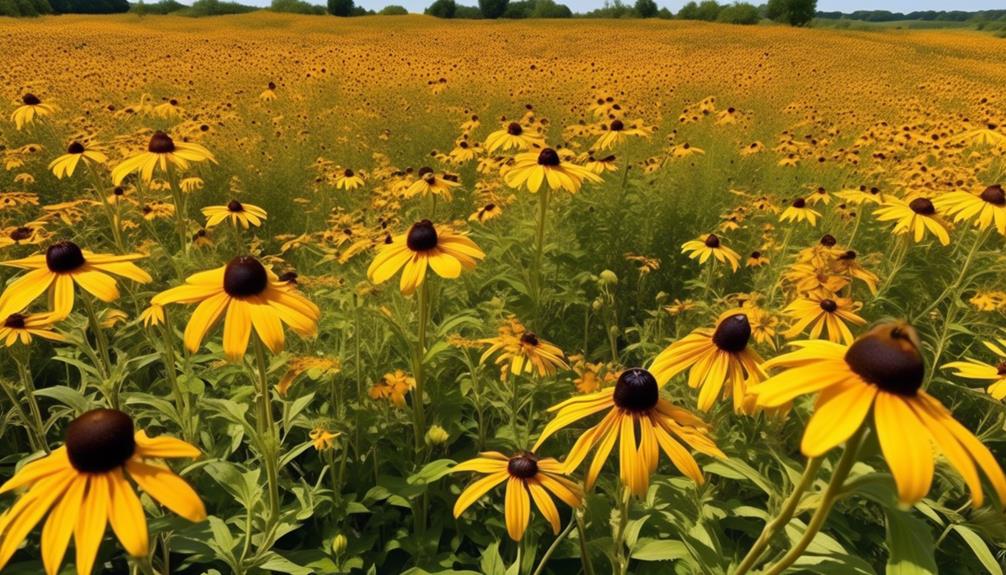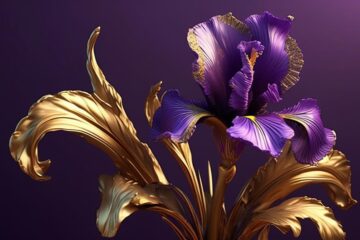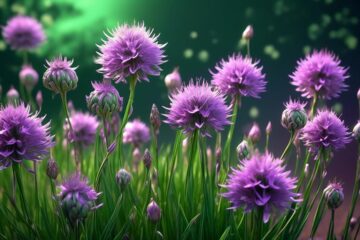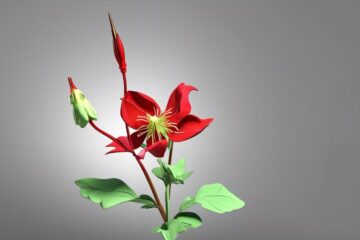Imagine a vast prairie, where the golden sun casts its warm glow upon the land, and amidst this natural tapestry, a vibrant flower stands tall, its bright yellow petals glistening like the golden eye of the prairie.
This flower, known as Black-eyed Susan, is more than just a beautiful sight; it holds a fascinating story and symbolic significance that captivates the imagination.
From its origins to its role in the language of flowers, there is so much to uncover about Black-eyed Susan and its enchanting allure.
So, join me on this exploration as we unravel the mysteries of this majestic flower and discover its secrets that lie within.
Black-eyed Susan: Prairie’s Golden Beauty
Discover the radiant allure of Black-eyed Susan: the prairie’s golden beauty. These stunning flowers, also known as Prairie Sun Black-eyed Susan, are a perennial plant that boasts bright yellow, gold, and mahogany blooms.
Native to the Midwest, they can be found throughout the United States and southern Canada in open woods, prairies, fields, and roadsides. Black-eyed Susans thrive in full sun and can tolerate various soil types, making them low-maintenance and versatile.
They’re perfect for annual or perennial beds, mixed borders, and cottage gardens. Pair them with ornamental grasses, blazing star, Russian sage, or blue mist spirea for a striking display.
With their vibrant yellow petals, Black-eyed Susans are sure to add a touch of golden beauty to any prairie landscape.
Story and Origins
The story and origins of Black-eyed Susan, also known as Rudbeckia hirta, can be traced back to the plains and prairies of the Midwest. This durable plant, with its vibrant yellow flowers, has naturalized throughout much of the United States and southern Canada. The species name hirta means “hairy,” referring to the roughness of the leaves and stems. One popular cultivated strain is Prairie Sun Black-eyed Susan, which can grow up to 3 feet tall and thrives in full sun and various soil types. It is a versatile plant that can be used in annual or perennial beds, mixed borders, or cottage gardens. While it can be grown from seeds indoors or outdoors, it is often short-lived and may act as an annual or biennial.
| Keyword | Fact |
|---|---|
| Black-eyed Susan plants | Native to the plains and prairies of the Midwest |
| Species name hirta means | “Hairy” referring to the roughness of leaves and stems |
| Prairie Sun | A popular cultivated strain of Black-eyed Susan that grows up to 3 feet tall, thrives in full sun and various soil types, and may act as an annual or biennial |
Symbolic Significance
Black-eyed Susans hold a symbolic significance, representing encouragement, motivation, and a positive outlook. These vibrant yellow daisies, also known as the Prairie Sun, bloom in late summer, bringing a burst of color and joy to the prairie landscape. Their symbolic significance lies in their ability to thrive in challenging conditions, symbolizing resilience and endurance.
Like the prairie sun, black-eyed Susans are a beacon of brightness and optimism. They’re often associated with support and empowerment, reminding us to stay motivated and maintain a positive outlook, even in the face of adversity. In Native American folklore, black-eyed Susans are seen as a symbol of guidance and protection, representing inner strength and a connection to the natural world.
Their symbolic significance goes beyond their natural beauty, embodying the wild and free spirit of the prairies.
Floral Language of Black-eyed Susans
As we explore the floral language of black-eyed Susans, you’ll discover the hidden messages these vibrant flowers convey.
Black-eyed Susans, also known as the golden eye of the prairie, have a unique language that they use to communicate with other plants and animals in their ecosystem. Through their bright yellow and gold blooms, they signal to pollinators like butterflies and bees that they’re a rich source of nectar. Additionally, their dark brown centers act as a visual cue, guiding insects towards the flower’s reproductive organs.
In the context of the prairie, black-eyed Susans symbolize endurance and resilience, as they can thrive in a variety of conditions.
Understanding the floral language of black-eyed Susans adds a deeper appreciation for these beautiful flowers and their role in the natural world.
Black-eyed Susan Watering Techniques
To ensure the healthy growth of your black-eyed Susans in the prairie, it’s important to implement effective watering techniques.
During the summer growing season, water your black-eyed Susans regularly, especially during dry periods, to keep the soil consistently moist but not waterlogged. It’s best to water at the base of the plant to avoid wetting the foliage, which can lead to potential fungal issues.
Adjust the frequency of watering based on the weather conditions and the moisture levels of the soil. Consider using a soaker hose or drip irrigation system to provide consistent and deep watering for your black-eyed Susans in perennial beds.
Additionally, mulching around the plants can help retain soil moisture and reduce the frequency of watering.
Gift-Giving Occasions for Black-Eyed Susans
When it comes to gift-giving occasions, black-eyed Susans offer a vibrant and meaningful option for a variety of celebrations. Whether it’s a birthday, housewarming, get well soon, thank you, or graduation, black-eyed Susans can bring joy and positivity to the recipient. Add a personalized card with an inspiring message.The table below highlights some of the occasions where gifting black-eyed Susans can be a thoughtful gesture:
| Occasion | Gift Idea |
|---|---|
| Birthdays | Bouquet of Black-Eyed Susans |
| Housewarming | Potted Black-Eyed Susans |
| Get Well Soon | Bouquet of Black-Eyed Susans |
| Thank You | Bouquet of Black-Eyed Susans |
| Graduation | Potted Black-Eyed Susans |
Black-eyed Susans, also known as Prairie Sun, are not only beautiful but also easy to grow. They can be planted from seed in early summer and are a great addition to butterfly gardens. Their golden petals and dark centers make them a striking choice for any occasion. Consider gifting black-eyed Susans to bring cheer, luck, and appreciation to your loved ones.
Concluding Thought
In conclusion, black-eyed Susans are a versatile and low-maintenance plant that adds long-lasting beauty and attracts pollinators to any landscape or garden. These Easy-to-Grow Perennials, such as the popular Prairie Sun variety, showcase stunning yellow petals with a dark brown center, creating an eye-catching contrast.
As the flowers bloom in late spring, they bring a burst of color and vibrancy to your outdoor space. Once the flowers have spent their beauty, you can simply remove the spent flowers to encourage new growth. Black-eyed Susans’ ability to self-sow ensures their continued presence in your garden, providing a consistent display of vibrant flowers year after year.
Whether you have a small garden or a vast landscape, these low-maintenance plants are a perfect addition, offering both beauty and ecological benefits.
Frequently Asked Questions
Do Black-Eyed Susans Come Back Each Year?
Yes, black-eyed Susans come back each year. They are perennial plants that can self-sow, so you won’t need to replant them. They thrive in full sun and require well-draining soil.
Do Black-Eyed Susans Spread Easily?
Do black-eyed Susans spread easily? Yes, they do! These vibrant flowers have a talent for self-seeding and can quickly take over your garden if not deadheaded regularly. So be prepared for their golden beauty to spread far and wide!
Where Is the Best Place to Plant Black-Eyed Susans?
The best place to plant black-eyed Susans is in a sunny area with well-drained soil. They thrive in low-maintenance landscapes and attract pollinators like bees and butterflies while deterring pests.
What Does the Black-Eyed Susan Symbolize?
The black-eyed Susan symbolizes encouragement, motivation, and a bright outlook on life. It represents loyalty and faithfulness, justice and fairness, resilience and adaptability, and can be used to honor loved ones.





